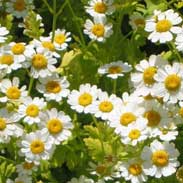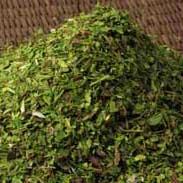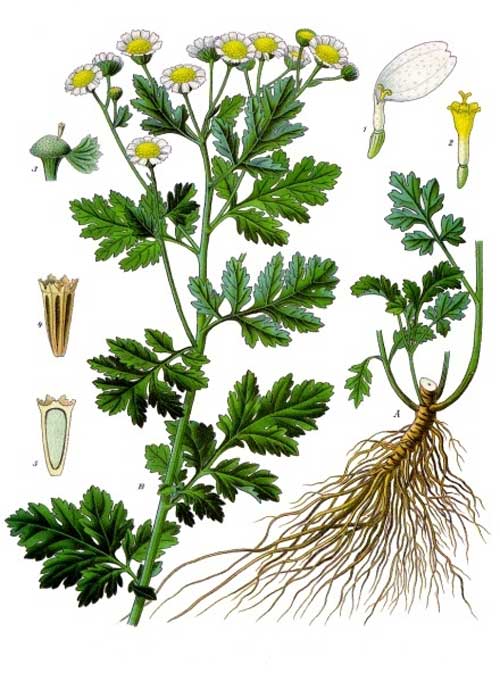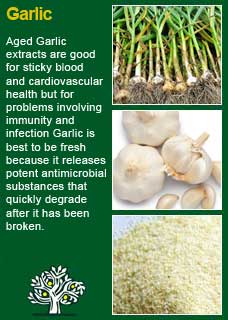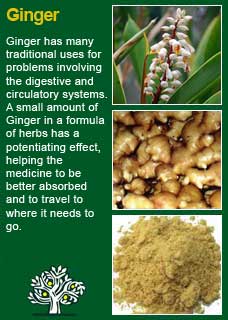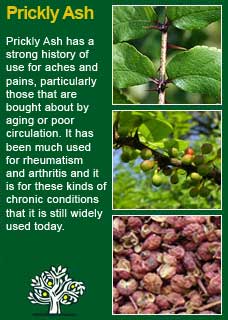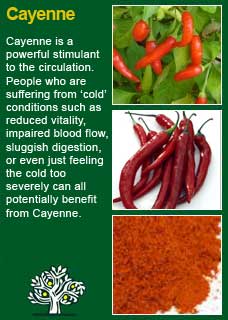
|
|
||||
| Our Pages ABOUT CONSTITUTIONAL MEDICINE
|
In herbal medicine, we use the leaves of Feverfew, a small but bushy and vigorous herb that rapidly spreads and covers available ground in a few years. Feverfew has been a part of medicinal herb gardens since antiquity and its name comes directly from the Latin word ‘febrifugia’ meaning ‘fever reducer.
Once something gets a name for doing a certain job it is hard to imagine it being able to do anything else. Feverfew has become well known as a natural migraine treatment in modern times and consequently all of its other traditional uses seem to have fallen by the wayside. That doesn’t mean those old uses don’t still hold true, we just don’t hear them talked about anymore.
Historically speaking Feverfew was mostly used as a women's herb to help ease menstruation and as Culpeper wrote 'as a general strengthener of the womb'. The ancient Greek and Roman physicians called it 'Parthenion' and prescribed it for menstrual and birth-related problems. The English herbalist Parkinson wrote 'Feverfew is very effectual for all pains in the head'. A century later John Hill wrote in 1772 that 'in the worst headache this herb exceeds whatever else is known'. Avicenna, in his Canon of Medicine, one of the most influential medical books in history, writes of Feverfew as ''dissolving the hot swellings of the stomach and the blood coagulated therein, it is a strong diuretic, it promotes perspiration, its inhalation of a patient with insomnia gives him relief and it is useful for earache, it is helpful in injuries to the nerves and the muscles' King's Dispensatory writes 'Feverfew is one of the pleasantest of the tonics, influencing the whole intestinal tract, increasing the appetite, improving digestion, and promoting secretion, besides having a decided action upon the renal and cutaneous functions. The warm infusion is an excellent remedy in recent colds, flatulency, worms, atonic dyspepsia, irregular menstruation, nervous debility, hysteria, suppression of the urine, and in some febrile diseases. The cold infusion or extract makes a valuable tonic. The leaves in poultice are an excellent local application in severe pain or swelling of the bowels, etc'
~ In a randomised, double-blind, placebo-controlled crossover study treatment with Feverfew (just 82mg per day for 4 months) was associated with a significant reduction in the number and severity of attacks and a significant reduction in the degree of vomiting in migraine sufferers (Murphy JJ, Heptinstall S, Mitchell JR. Lancet 1988; 2(8604):189-192) ~ A double-blind, placebo-controlled crossover study involving people with chronic migraine showed that Feverfew (100mg per day for 2 months) produced a highly significant decrease in pain intensity. In the second phase of this trial, the group who remained on Feverfew continued to experience a decrease in pain intensity and a highly significant reduction in vomiting, nausea and sensitivity to noise and light during attacks. Participants who switched to placebo experienced an increase in pain intensity. In the third phase of this trial transferring the feverfew-treated group to placebo resulted in an increase in pain intensity and other symptoms and shifting the placebo group to Feverfew therapy resulted in an improvement in pain and other symptoms (Palevitch E, Earon G, Carasso R. Phytother Res 1997; 11(7):508-511) ~ A survey of people with headache using Feverfew revealed that the frequency and severity of migraine headaches and tension headaches was much reduced. Associated nausea and vomiting decreased or disappeared and the effectiveness of conventional painkillers increased with concurrent use of Feverfew. Relief of arthritis symptoms was also experienced. The dosage was just 2-3 fresh leaves per day and it was noticed that the onset of benefit at this (quite low) dose was slow in many cases (Johnson ES. Feverfew (overcoming common problems). Sheldon Press, London, 1984; pp42-45) ~ Following the above study a much more rigorous double-blind, placebo-controlled trial was commenced in patients who had been self-medicating with the raw Feverfew every day. The ones who had been using it for 3 months who continued with unmarked Feverfew capsules continued without any worsening but the ones who went to the identical in appearance placebo capsules experienced a significant increase in the frequency and severity of headaches, nausea and vomiting (Johnson ES, Kadam NP, Hylands DM et al. Br Med J (Clin res Ed) 1985; 291(6502): 1128) ~ The authors, titles and the 'where-and-when' published of nearly 80 further studies and articles on Feverfew are listed in a PDF found here
Feverfew is a potent herb and is best used moderately. If you take too much of it then there will likely be a sign from the body such as disturbed digestion or some discomfort in the mouth or head. Don't automatically take this as a sign that it is the wrong herb for you but rather consider that may be simply taking too much of it than is good for you!
For some years now, against this proven and safe way of herbalism, there has been a rising tide of excessive caution and scare-mongering in many parts of the world. The same authorities that, not so long ago, decried herbal medicines as ineffectual, have now taken up a different adversarial position; that they are dangerous substances that should only be prescribed by Doctors, who of course have zero training in them. Unfortunately, the same unnecessary fear and worry has crept into many natural health websites and popular publications on herbs. Herbs that we have safely used for thousands of years, that have no reports of adverse reactions in the medical literature despite widespread use by millions of people, are suddenly described as contraindicated because of something that should have been seen as completely unimportant, or at the utmost a merely theoretical concern, such as a laboratory study on one of the herb's constituents to use an all too common example. I wonder sometimes if the writers of such articles feel that the herb will be more deserving of respect if it is thought to be a little bit dangerous, in other words more like a drug than something that has simply come out of the earth and been used by ordinary people for generations beyond count. There is just so much misinformation about herbal medicine on the internet now. Ludicrous claims and cautions abound in equal measure; it seems like one group are trying to make money out of the public whilst the other are busily trying to scare them off. I have to believe that the kind of reader who takes the time to read pages on herbs that are as extensive as this one is much less likely to be swayed by marketers or misinformers. I hope that you will keep your wits about you if you get conflicting opinions from people who have never really got to know these herbs, who have never worked with them, or learned how to use them safely and effectively. I want to remind you that the reason that herbs can never be patented and owned by any individual or corporation is because they are, and always will be, the People's medicine. They belong to all of us and it is my great hope in sharing this work that you will learn how to use them wisely for yourself, and the people you care for. Be safe, but do not be afraid.
I have given Feverfew to many people over the years and, so long as it is the right herb for the person, I have seen it do a great deal of good in reducing pain and improving quality of life. I do think of Feverfew when people come in with chronic headaches or migraines but there are other times I feel called to use it and this is when I see 'stuck-heat' in the body. 'Stuck-heat' is just an old-fashioned way of saying what is now more commonly called 'inflammation' but I think this old phrase conveys a sense of how this painfully common problem might be better understood in a more constructive way. The body is not somehow invaded by inflammation as if it were some kind of infection; whenever there is a chronic tendency to 'stuck-heat' there are always causes and contributors in that person's life. For example, in how they work and rest, in how they live, in how and what they eat etc. It can also be seen that wherever it is that a person gets stuck-heat in their body, whether it be their head, their joints, their belly or their back etc. it can be seen that there are things that can make the pain either better or worse. At the top of most people's list for making it better are those coldest of all drugs - anti-inflammatories. Less well known but just as likely at or near the top of the list for what makes things worse are those factors that add to the stuck-heat including things like physical or emotional stress, lack of sleep, excess junk foods, sugar or alcohol, even changes in the weather! For a much more detailed holistic picture in these matters I recommend anyone reading this who has migraines to read here, with osteo-arthritis to read here, or with back pain to read here. Above all I want to convey the idea of complexity when it comes to stuck-heat (inflammation). That simply taking a drug in the form of trying to put out a fire may give a short-term relief but if the causes of the problem are not being addressed then things generally get worse rather than better in the long term. If you who are reading this are studying herbal medicine or perhaps have your own cogent reasons to get a deeper understanding of this potent plant ally then I urge you to take a small dose of Feverfew tincture or chew some of its fresh leaf and then closely observe your body and how it makes you feel in order to get a sense of just exactly it does work. I think that if you do this with a quiet and attentive mind then you will be able to feel for yourself this moving of 'stuck-heat'. The herb gets in under the surface of your senses and continues to exert its influence long after its distinctive taste has faded away. Further to this, if you would like to learn more about the ancient art of pulse testing, a simple but powerful way to ask the intuitive intelligence of the body for its responses to a herb by feeling the pulse whilst giving a tiny dose by mouth, read here In practical terms in tincture form in my own practice this usually means as little as 1 ml in a day or if in a tea form as little as a half a level tsp of the dried herb (I personally think it works better as a 'cold extraction' i,e, the fresh plant or a tincture over a tea). Once you get the body used to having a small regular dose of Feverfew then it is all about patience; this is a herb that can do great things to shift problems that may have been stuck for many years, but you must be patient with it... Feverfew is a great herb to use alongside other remedies, for example it will often combine perfectly with herbs such as Garlic or Ginger for sticky blood and to help move the blood when it is sluggish or congested it can work very well with Prickly Ash or even Cayenne.
Much of the information here about the traditional uses of Feverfew is consistent with the model of thinking whereby one may treat problem A with plant B. There is value in this approach, especially in how it helps us pass on useful knowledge to one another, but it falls short in one vital area; and that is that people are not all cut from the same cloth! Something that works brilliantly for one person may do less for another -- why is this? Part of the reason is that people vary in their constitutions as to whether they are either hotter or cooler and, at the same time, either dryer or damper. This useful and rather fascinating subject is introduced further here Another big part of using the right herb when it is most needed comes from understanding the need to treat what is going wrong for the person that had led up to their getting a health condition. In this light, Feverfew can particularly offer its benefits when an activation is needed in the 'cycle of healing', more about this here
Please understand that I cannot advise you, including on products or dosage, without seeing you in person in my clinic but for ideas
on how you might find a good herbalist in your area read here |
|
|
© 2011 R.J.Whelan Ltd

